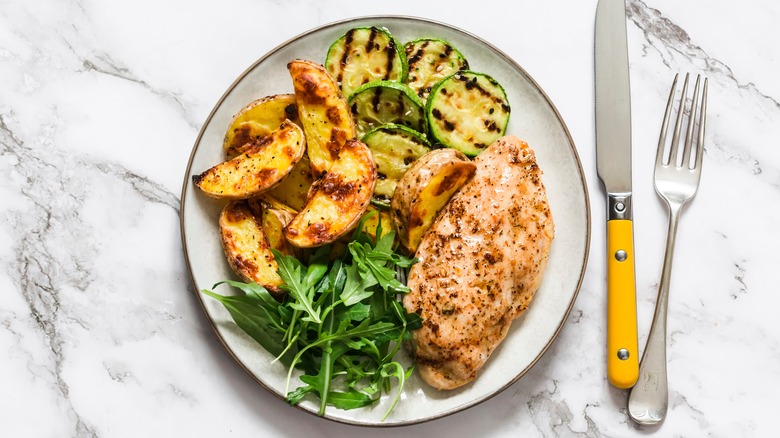What Is The Leanest Type Of Meat?
Eating healthy might sound complex. A diet change may feel out of reach, especially if you're on a budget or pressed for time. There is a simple way to improve the quality of your meals and health. All it takes is one minor change -– adding lean protein.
When you prepare a plate, the well-known main food groups are actually called macros. Macronutrients are vital for good health because our body uses large amounts of them daily. These macros consist of carbs, fats, and proteins (via MyPlate). In a well-rounded diet, protein likely makes up 25% or more of each meal. The aminos in protein act as building blocks for our skin and muscles (per Precision Nutrition). This nutrient is crucial. Protein helps our body make hormones, repair damaged skin, and recover from injuries. We can't live without it. In fact, Health Digest noted that our body cannot produce the 9 essential aminos packed into one complete protein. Seeing that protein types vary, we want you to get the leanest and meanest bang for your buck.
When comparing proteins, Health Digest clarifies that animal meats are filled with complete proteins, while plant-based proteins are incomplete. Animal proteins give us the iron and vitamin B12 that our leafy, phyto friends don't (via Medical News Today). On the flip side, a recent study in Nutrients found that frequently eating meat may increase total body fat and the obesity risk. However, it's possible to find a meat-eating medium — without going vegan.
Choosing the healthiest meats
You probably heard it from vegans first: Red meat is less healthy than "white" meat. They do have a point. The term lean is synonymous with low in fat. Red meat is controversially high in cholesterol. Livestrong announced they consider the fittest proteins to be poultry and fish. Chicken tops the list of least fatty proteins, according to Men's Journal. Livestrong mentioned, 'The dark meat and skin are the fattiest portions, so try and stick with the breast." You can trim away the fat or opt-in on boneless. Maybe you prefer ground meats to prep and make burgers? ProHealth suggests checking labels for meats in the lean quadrant of 90% or better.
Since protein is important for immune function, training performance, and metabolism, it's important we eat enough every day (per Precision Nutrition). The USDA's general recommendation is about 5½ ounces daily — about the size of a deck of cards per meal. Experts at Precision Nutrition stated, "The body needs its protein stores to be continually replenished, which means that you should consume moderate amounts of protein at regular intervals ..." The amount of protein a particular person needs will vary based on the intensity of their workout routine and daily activities. Registered dietician Jennifer McDaniel suggests that each meal plate should be one-quarter to one-third.
The healthiest meat options are poultry and fish, but how you cook them is equally important. ProHealth noted grilling and baking are optimal cooking methods.


